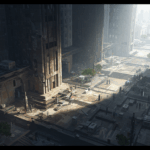No one noticed that small shadow beneath the old building’s balcony. A shadow no larger than two square meters — yet it was the only place in the neighborhood where elders could sit in the morning without being scorched by the sun. When engineers came to renovate the building, they didn’t remove it — they made it the center of the new design.
The shade was expanded. Benches made of recycled wood were placed around it. Plants tolerant to heat were added. It was no longer just a place to sit — it became a meeting point. Neighbors who hadn’t spoken for years began exchanging news about their children. Children started drawing on nearby pavements. The shade wasn’t an architectural element — it was social fabric.
In another project, in a barren industrial area, the team was asked to design an “efficient” administrative building. But they added something unrequested: a small internal courtyard with a quiet fountain and shaded benches. It wasn’t “necessary,” but it became the place where workers rested during breaks, sipping coffee and catching their breath before returning to production lines.
There’s a kind of design not measured in square meters or energy efficiency — but in the comfort it generates. In the quiet it grants. In the dignity it restores to humans in environments that often treat them as numbers on a spreadsheet.
Even in massive infrastructure projects — bridges, roads, stations — shade can be present. Not always literal shade — but metaphorical: safe bike paths beside highways, small gardens above tunnels, nighttime lighting that guides footsteps instead of blinding eyes.
Good engineering doesn’t just build — it embraces. Doesn’t just construct — it nurtures. Because humans don’t live in projects… they live in their small details — details often ignored by those who count cost alone.






